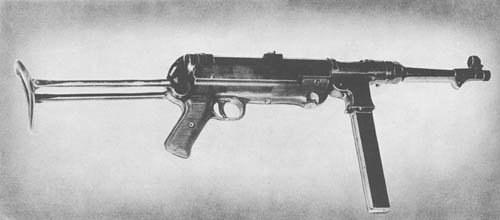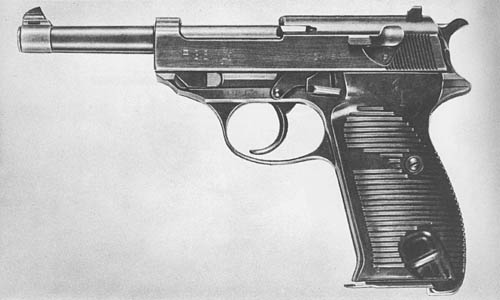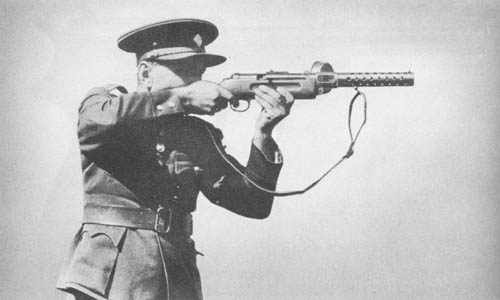
This submachine gun was originally designed for use by parachute troops but is now in general use in all combat units of the German Army. It is a gun of simple construction, reliable operation, and general accuracy.
The Model M.P. 40 like its predecessor the M.P. 38 is air-cooled, blowback operated, and fitted for a 32-round box magazine. It can be used as a shoulder or hip weapon, being equipped with a folding shoulder stock.
As the trigger is pulled, the sear disengages the sear notch in the bolt. As the bolt travels forward it pushes the top round from the magazine into the chamber. The extractor keeps the firing pin from hitting the primer until the round is chambered then snaps under the cannelure of the cartridge allowing the base of the cartridge to come back against the face of the bolt. As the cartridge is fired, the bolt starts to recoil. At the proper point, the ejector hits the base of the cartridge, pivoting it out into the ejection opening. The bolt compresses the operating spring at the same time. The buffer plunger hits the end of the small operating spring tube, compressing the buffer spring and stopping the recoil of the bolt. The bolt then moves forward to repeat the cycle of operation.
SPECIFICATIONS
| Caliber | 9 mm (actually .347 in.) | |
| Weight with loaded magazine | 10 lb., 7 oz. | |
| Weight with empty magazine | 8.87 lb. | |
| Length with stock extended | 33.25 ins. | |
| Length with stock folded | 24.75 ins. | |
| Barrel length | 10 ins. | |
| Capacity of magazine | 32 rounds | |
| Sights | ||
| Front | Partridge type ramp with hood | |
| Rear | ||
| Fixed | Open V notch, sighted at 100 meters | |
| Folding | Open V notch, sighted at 200 meters | |
| Muzzle velocity | 1,040 f/s-1,250 f/s | |
| Range, effective | 200 yds. | |
| Rate of fire (practical) | 80 to 90 r.p.m. | |
| (cyclic) | 518 r.p.m. |
German: p. 206

